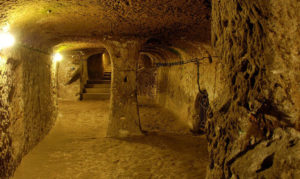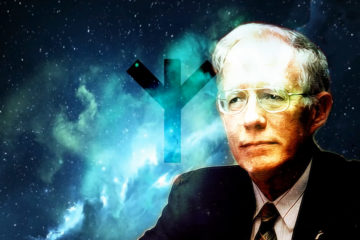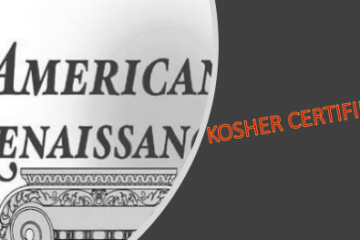Who We Are #6 — The Lost Civilization of Old Europe

by Dr. William L. Pierce
Civilization of Old Europe Was 2,000 Years Ahead of Middle East
Most Ancient Civilization Finally Being Uncovered
BEFORE WE CONSIDER the racial and cultural complexities of the Neolithic period and the ensuing Bronze Age, let us briefly summarize the principal developments of the first five installments in this series.
From the Beginning, some 15 billion years ago, we traced the ongoing self-creation of the Cosmos through an ascending continuum of evolutionary stages. We saw the first biological life appear on the earth 3.5 billion years ago, and we followed its development through ever higher and more complex forms, from protozoan to mammal, in the Cosmic quest for self-consciousness.
Antiquity of Races
We saw the primate line separate from the rest of the mammals 70 million years ago, and 25 million years ago we saw the hominid line — man’s ancestral line — split off from that of the pongids (manlike apes). After that the hominid line continued to evolve, and by sometime late in the Pliocene epoch, about four or five million years ago, it had diversified into several distinct races of Australopithecines.
The Australopithecines were chimpanzee-sized primates who hunted and ate other animals and made and used simple stone tools. Near the beginning of the Pleistocene epoch, approximately three million years ago, one of the more advanced races of Australopithecities expanded beyond the tropical savanna of Africa, which was its original habitat, into the earth’s northern temperate zone. To this race belonged European man’s prehuman ancestors. Although no Australopithecine fossils have yet been found in Europe, artifacts have been found there which must have been made by Australopithecines.
Under the greater selective pressure of the northern environment, these early ancestors of ours evolved — culturally, biologically, and socially, the three aspects strongly interdependent — much faster than their cousins who remained in the tropics. They crossed the threshold from Australopithecus to Homo erectus, and then finally reached the sapiens level about three-quarters of a. million years ago, hundreds of thousands of years before any of the non-White races. Vertesszoelloes Man, whose fossils in Hungary are of that age, still retained many of the primitive features of H. erectus, but his brain was large enough to qualify him as H. sapiens.
Mediterranean Separation
The descendants of Vertesszoelloes Man continued to evolve throughout the more than 600,000 years of the Middle Pleistocene. As we saw, European culture advanced from the crude handaxes of Vertesszoelloes Man to the finely crafted implements of stone, wood, and bone made by men on the edge of the northern European plain during the Riss-Wuerm interglacial period, about 150,000 years ago.
It was from this time, immediately prior to the Neanderthal phase of human development, that the separation of the European stock took place which led eventually to the Cro-Magnon subrace on the one hand and to the widely varied group of racial types which have been classified as “Mediterranean” on the other hand. This separation, which was never total, came about as the result of a complex of changes involving climate, habitat expansion, and lifestyle.
Cro-Magnon Ancestors
During the relatively mild Riss-Wuerm interglacial period, the first Europeans began living in the northern plain. They were a relatively advanced group, whose cultural attainments made it possible for them to adapt successfully to the new habitat.
But others remained in the southern coastal areas of Europe and in the adjacent portions of northern Africa and the Middle East. As the Wuerm glaciation brought a more severe climate to Europe, those who had remained in the south were effectively kept there. There was a certain amount of gene transfer with their neighbors to the north during the next 100,000 years, but there was also some genetic contact with non-European races to the south.
The net result was that when the Cro-Magnon subrace — a tall, ruggedly built, large- headed subrace with a large degree of sexual differentiation — appeared in Europe about 40,000 years ago, it differed to a greater or lesser extent from the various Mediterranean types to the south and southeast.
Variety of Mediterraneans
Some of these Mediterraneans — those who had continued to exchange genes with the northern Europeans during the Wuerm glaciation — can be considered as kinsmen of the Cro-Magnons and as fully White. They differed primarily in being somewhat more gracile (less rugged and angular in bony structure) and in having somewhat smaller heads and narrower faces and jaws.
Others, whose genetic contacts were less with Europe and more with the Middle East and Africa, differed substantially from the Cro-Magnons. Most of these were much shorter (although there were notable exceptions, e.g., in northeast Africa) and more gracile than the Cro-Magnons, pedomorphic, and — judging from their descendants — dark. Their heads were smaller and their facial structure quite different — so different, in fact, that they should not be classified as White.
Racial Classifications
European anthropologists have developed a somewhat involved scheme of racial classification to comprise these non-White Mediterraneans, with groupings designated as Hither Asiatic, Oriental, Hamitic, etc. Since we are concerned only with the ancestors of today’s Whites, we will not become involved further with the subtleties of these groupings but will merely try to indicate whether any particular Mediterranean group should be considered fully White, marginally White, or non-White. Because of the racial mixing which has taken place in the Mediterranean area, with a consequently large number of gradations of racial character, such indications may sometimes be arbitrary.
Neanderthal Period
The period between 150,000 and 40,000 years ago, corresponding to the first Wuerm glacial advance, was the Neanderthal period. There has been a great deal of confusion about Neanderthal Man in the past, based primarily on the fact that the fossil specimens originally taken as typical were not really representative of most Europeans during this period but represented instead a local and rather specialized variation of the race.
The evidence which is available now indicates strongly that the Neanderthal phase was neither a regression nor the result of a major genetic intrusion, but instead was a smooth continuation of developments rooted in the pre-Neanderthal period. Both culturally and biologically a continuum has been established between the northern Europeans of the Riss-Wirerm interglacial period and the more generalized northern Neanderthals of the first Wuerm advance.
A similar continuum joins the southern varieties of Neanderthal Man with the inhabitants of the Mediterranean and Middle Eastern areas during the Riss-Wuerm interglacial.
The more highly specialized Neanderthals — i.e., those with heavy brow ridges, prognathism. and other “regressive” peculiarities — either died out or were absorbed by their neighbors.
Upper Paleolithic
The Cro-Magnon subrace, which was the principal racial element in Europe during the Upper Paleolithic and Mesolithic periods — i.e., from about 40,000 years ago until the introduction of farming 6,000-8,000 years ago — is represented today by groups of Upper Paleolithic survivors in Ireland, northern Germany, Scandinavia, and other parts of northern Europe. They were described and pictured in the fourth installment in this series.
The Cro-Magnon homeland may be considered to be the vast northern European plain, stretching from the Alps in the south to the North Sea and the Baltic Sea in the north, and from Ireland in the west to the Urals in the east.
Alpine Subrace
The Alpine subrace, which was described in the fifth installment, has been derived from the Cro-Magnon subrace through a complex of genetic changes involving a reduction in stature, a decrease in relative head length, a slight decrease in sexual differentiation — and, perhaps, some Mediterranean admixture. The Alpine homeland is the mountain belt stretching across western and central Europe – i.e., it is in that region that Alpines have historically constituted the largest portion of the population.
And the various Mediterranean types, whose ancestors developed more or less separately from the Cro-Magnon subrace, have their homelands along the African and European shores of the Mediterranean Sea and in the Middle East.
Population Explosion
When men everywhere lived by hunting, fishing, and gathering natural vegetation, population densities were everywhere quite small: on the order of one person for every five square miles of habitable land. When they began living by farming and raising livestock, however, population densities rapidly increased more than a hundredfold.
We noted in the fifth installment that it was in the Mediterranean racial area, on Europe’s borders rather than in its interior, that the Neolithic revolution began. And, thus, beginning about 9,000 years ago, the Mediterraneans gained a strong numerical advantage over the Cro-Magnons and their Alpine relatives. Several groups of Mediterraneans, representing several varieties, were able to push northward and westward into Europe, initially swamping the sparse hunter-gatherer population.
Even though the Cro-Magnons themselves experienced a population surge when they became farmers, the initial advantage of the Mediterraneans resulted in a lasting Mediterranean numerical dominance in many areas which had formerly been Cro-Magnon. Most areas of Mediterranean penetration became racially mixed, with the ratio of Cro-Magnon to Mediterranean blood varying from place to place.
Tall, Blond Warriors
But the Mediterraneans were not the only ones to invade the Cro-Magnon areas of Europe during the Neolithic period. From the steppes of southern Russia, in the region between the Black Sea and the Caspian, came wave after wave of a subrace which differed from all the others we have encountered thus far. Not quite as ruggedly built as the Cro-Magnons, yet more so than the Mediterraneans, they were tall and fair.
They may have learned the arts of agriculture from earlier contact with a nearby Mediterranean group, or they may have developed farming on their own, but, whichever the case, they were already carrying these arts westward and northwestward with them nearly 6,000 years ago. Superb craftsmen as well as farmers and cattle breeders, they were, above all else, warriors. Wherever they went they conquered and ruled.
Nordics Take Lead
And their culture ruled also. Their language replaced the language of the conquered peoples everywhere, as did also their religion, their art, and their social customs. They were the Nordics.
The Nordics will play the leading role in this series henceforth, just as they have in the world for the past 6,000 years. But let us fix in our minds a few of the more significant general features of the European world of the Neolithic period which we have not considered yet, before we focus our attention on the Nordics.
First Farmers
The Neolithic revolution had reached the northernmost corners of Europe by 6,000 years ago. It brought with it certain changes in stone technology initially, but these were of relatively minor importance compared to the far-reaching social changes accompanying the replacement of the hunting-gathering lifestyle by the farming-livestock raising lifestyle.
As already mentioned, the new lifestyle was more efficient, and it allowed a given area of land to support a much larger population. The most significant social change which came with this higher population density was increased specialization: a much more pervasive and highly structured division of labor than had existed with the Mesolithic or Paleolithic lifestyles.
Interdependence and Innovation
Men ceased being jacks of all trades, each dependent entirely on his own efforts or those of his immediate family for his food, his clothing, his shelter, his weapons, and all his other needs. Instead, various individuals specialized in trades, supplying the needs of several families or of a whole village with the fruits of their skilled labors and depending in turn upon individuals in other trades for supplying some of their needs.
There had been a certain amount of specialization among hunter-gatherers, but never before to such an extent. Europeans lost some of their independence with their increased division of labor, but with the new interdependence came an enormously increased rate of cultural innovation. The man who could spend a lifetime doing nothing but making pots had a chance to learn how to do it exceedingly well — much better, at any rate, than his predecessor who had been obliged to spread his attention and his labors over a much broader field of endeavor.
Social Organization
With the division of labor came new divisions of wealth and social status. Social classes came into being: a class of peasants and craftsmen, a class of warrior-rulers, a class of priests. Society became truly organized for the first time.
These new social developments came about first in that part of Europe where the Neolithic lifestyle first took hold. From Crete and the coastal areas of Greece and southern and eastern Italy they had spread by 8,500 years ago to a wide area of southeastern Europe, encompassing all of the Balkan peninsula and extending from the head of the Adriatic Sea the Dniester-Dnieper region northwest of the Black Sea. Included were all of modern Austria, Hungary, and Romania and part of the Ukraine.
Hard-fired pottery was being produced in the Balkans by this time, which was also about when it first appeared in the Middle East, although the most recent findings seem to give precedence to the Balkans. Within another millennium — i.e., by about 7,500 years ago – – a complex civilization had sprung up throughout this entire southeastern European area.
This Old European civilization, as it has been recently named, boasted walled towns of more than 1,000 inhabitants (one near Kiev had 20,000), with stone temples and brick houses. Copper objects were being produced at several sites, and a linear script had come into use. This latter development was nearly 2,000 years ahead of a similar development in the Middle East.
Strictly European
Although extensive trade in both raw materials and manufactured products was being carried on with Asia Minor and the Middle East, it should be emphasized that the Old European culture of 7,500 years ago was strictly European and not a Middle Eastern import. The Mediterranean farmers who began spreading from the coastal areas into the Balkan interior 9,000 years ago brought sheep, goats, and barley (which were not indigenous to Europe) with them, but after that initial impulse the Old European culture developed in its own distinctive way, independently of the Middle East.
The Old European civilization lasted about 3,000 years — i.e., until about 5,500 years ago — and then it disintegrated utterly. Its temples and gods, its towns, its language — all disappeared in an overwhelming disaster: the arrival of Bronze Age Nordic warriors from the east.
Lost Civilization
It may seem surprising that so little was known of the Old European civilization until the archaeological findings of the last few years, considering the fact that it flourished so long and reached such heights right in the European heartland. How is it that we know so much more about the ancient civilizations of Mesopotamia and Egypt than about a civilization so much more important to us?
Part of the answer undoubtedly is that the Old European civilization thrived in an area which has been much more exposed to the ravages of time, with armies and migrating streams of people crossing and recrossing it throughout the last 5,500 years, while the ruins of other civilizations have lain abandoned and relatively undisturbed.
Undeciphered Script
And part of the answer lies in the thoroughness of the transformation wrought by the Nordic conquerors of Old Europe. In Egypt, despite invasions by alien peoples from time to time, and despite the gradual racial mongrelization of the Egyptians, there has remained a certain degree of continuity over the last 5,000 years. But of Old Europe there remains hardly a trace above ground.
We are unable to decipher a single Old European inscription, and only in a few modern European place names does any evidence of their language survive, much in the way American Indian place names survive in this country today. Besides the artifacts and fossils now being unearthed by archaeologists, one of our few sources of knowledge of the Old Europeans may lie in the religious myths of the descendants of their conquerors, as we shall soon see.
Room for Dreaming
A tantalizing thought is that the fantasies of writers such as Robert E. Howard, with his Cimmerian hero Conan the Barbarian living, loving, and fighting amid the splendors of a vanished, ancient civilization, become less fantastic the more we learn of Old Europe. During its 3,000 years of efflorescence there may even be room to fit in J.R.R. Tolkien’s Middle Earth and the wonders of Gondor, Rohan, and Mordor!
In any event, our ideas of European prehistory have certainly been stretched during the past few years of discovery.
The creators of the Old European civilization were a blend of the Mesolithic Cro-Magnons originally in the Balkan area and the Neolithic Mediterraneans who infiltrated the area, beginning a little over 8,500 years ago. Most of these Mediterraneans were of a variety anthropologists call Danubian, and they were short, gracile, and pedomorphic.
Because the Cro-Magnon population differed physically in so many respects from the Danubians, there were substantial geographical variations in racial type in Old Europe, depending on the proportions of the two basic stocks present in the blend. When the Nordics arrived, the geographical racial pattern became even more varied. The racial homogeneity which had existed in most of Europe during the Upper Paleolithic period was gone for good.
In the next installment we will consider certain aspects of the interaction between the Nordics and the citizens of Old Europe, and we will also look at the Megalithic culture of Western Europe.
* * *
Source: National Alliance





